Felting is the process of making felt from spring and fall sheep's wool. When felting, such techniques as mowing, picking, pulling up, soaking with water, as well as kicking, steaming, rolling with hands, and couching are used.
Making clothes and products from felt dates back to ancient times. Information about felt in nomadic life and how it served can be found in the records of medieval travelers such as Marco Polo, Plano Carpini, and Clavijo.
Felting reached its heyday before the Middle Ages. Ancient methods of felting described by early travelers were preserved among Kazakhs, Kirghiz and other peoples until the twentieth century. The main organizers and performers of felting in the traditional Kazakh environment were women. Every Kazakh woman perfectly mastered the ancient technologies of felting. Because, as one of the researchers of Kazakh life of the XIX century M. Krasovsky said, “... Kazakhs teach girls sewing, web weaving, felting, etc. from a young age, and with age they demand everything from them”.
Carpet is the name of a household product made of wool or cotton threads. Carpet is used for wall and floor coverings as a home decoration and to keep a room warm.
The art of carpet weaving dates back to very ancient times in Central Asia and Kazakhstan. In the opinion of S.M. Dudin, who made an invaluable contribution to the study of Kazakh ethnography, carpet (and other fabrics, of course, primarily felt products) is a skillful creation of nomadic life. This idea of the scientist is obvious, as it comes from the point of view of the origin and application of carpet in nomadic ethnocultural environment, taking into account the ecology of use, vital importance and aesthetics. Simple, but skillfully executed harmonious and beautiful line of carpet ornaments reflects centuries-old aesthetic taste of the people.
Syrmak is a patterned felt carpet. The color is made of different felt cutouts (mostly black and white), the background is made on one colored surface by patchwork sewing technique (“kurak”); in this composition the edges of the pieces of cloth on the front side are sewn with threads of different colors. The composition on the surface of the carpet is quite complex - it is made in the pattern “border”, has dividing beams, lining, dividing the central area. There are three large rhombuses, around which plant-type patterns are placed.
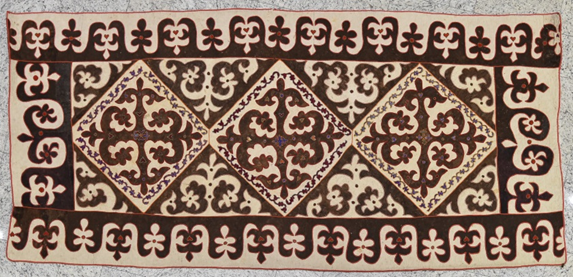
Syrmak. From the fund of the National Museum of the Republic of Kazakhstan.
Pile carpet “Samauyrgul”. A carpet, the main lining of which is made of pile. Patterns of such carpets traditionally consist of three parts: the edge of the carpet - the border, water - the part dividing the patterns in the background, and lake-shaped parts in the central zone. In the central part of the rug there is a set of patterns in the form of a large rhombus surrounded by patterns made with threads of different colors. The flat edge of the border is filled with red, purple, green, pink, blue patterns on a light orange background. The sides of the rug are covered with fringe.
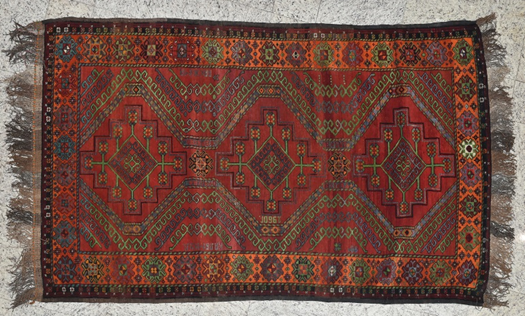
Pile carpet. From the fund of the national museum of the Republic of Kazakhstan.
Lint-free carpet (alasha). The carpet is rectangular in shape, stretched vertically. It is sewn from woolen threads of different colors. Between the strips “through the border” hand stitched black and brown wool threads. Knitted by the method of “terme” (the main part of the threads of different colors, cross threads - one color). Multicolored threads woven along the length form a series of geometric patterns arranged vertically.
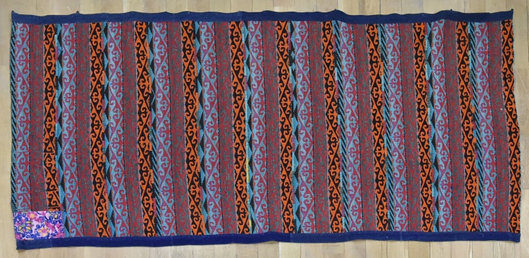
Lint-free carpet (alasha). From the fund of the national museum of the Republic of Kazakhstan.
Tuskiiz. The wall carpet of rectangular transverse form, polychrome embroideries have vegetative-geometric character. In the central part inside the rectangle there is a set of patterns of dark maroon color, surrounded by small bunches of orange flowers. The edge of the rug is trimmed with a flat light red fabric. The main colors of the embroidery are red, pink, lilac, blue, green, shades of brown, pink, and black. This type of rug is accompanied by a quilt as a set, so the bottom is not trimmed.
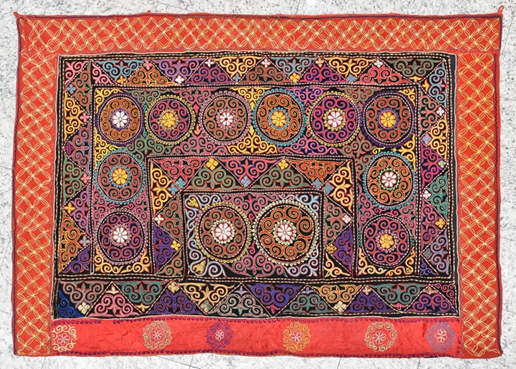
Tuskiiz. From the fund of the national museum of the Republic of Kazakhstan.
Takyr korzhyn (“lint-free bag”). A traditional type of bag with two pockets connected to each other. Knitting started from the outer side of the pocket. Usually, the bag is woven of lint or lint-free and decorated with composition patterns.
First the back of the right pocket is knitted and goes to the outside of the pocket, then the middle, then the second pocket is knitted from the back to the outside, with the composition of the pattern perfectly repeating the right pocket. The result is a fully woven weave.
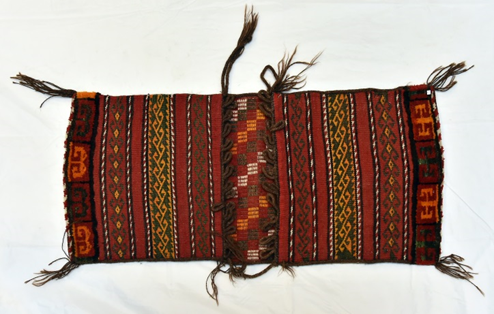
Korzhyn. From the fund of the national museum of the Republic of Kazakhstan.
Ayakkap. Of white felt, with a lining of red velvet on the inside. The corners of the rectangular line in the central part are cut, and its inner part is decorated with rhombuses in the form of teeth. In the center of the rhombus are cross-shaped patterns with sharpened ends. The rhombus circle is framed by scalloped edges of yellow color. The borders are repeated several times. The central rectangle itself is located in the center of the S-shaped expressions. In addition, the front part is framed by multicolored ornaments, the edge of which is made in the form of teeth. Between the surrounding rhombuses are triangles. The edges are bordered with fringe.
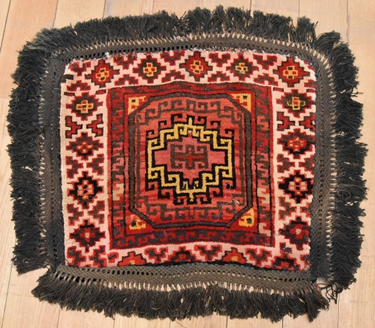 Ayakkap. From the fund of the national museum of the Republic of Kazakhstan.
Ayakkap. From the fund of the national museum of the Republic of Kazakhstan.




